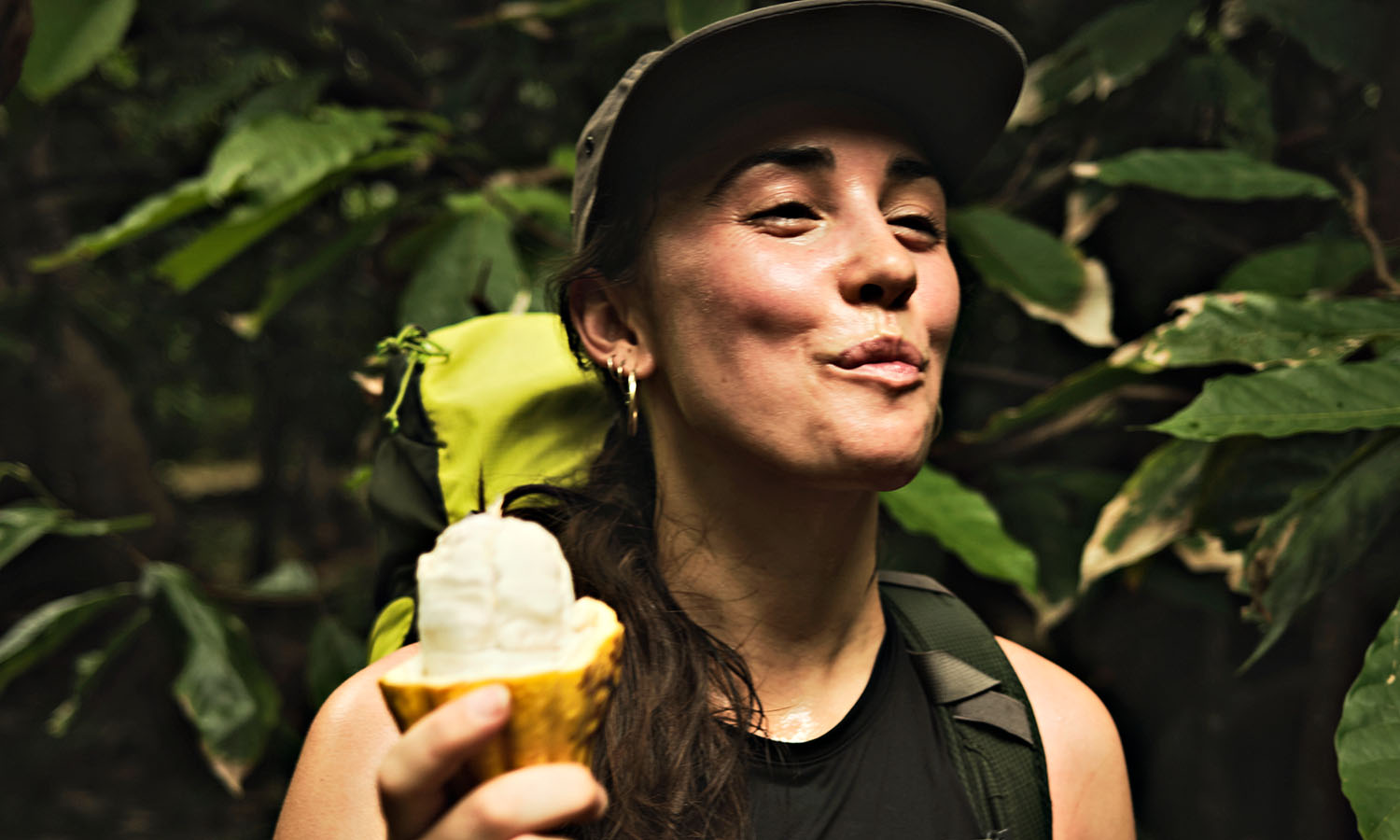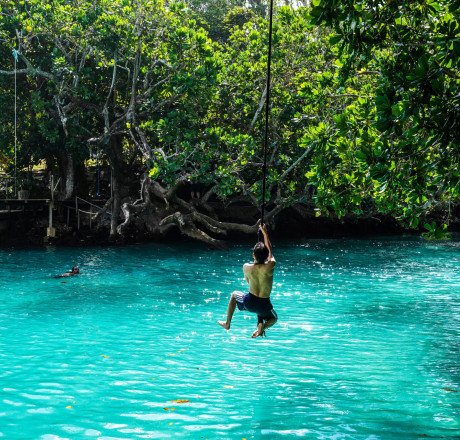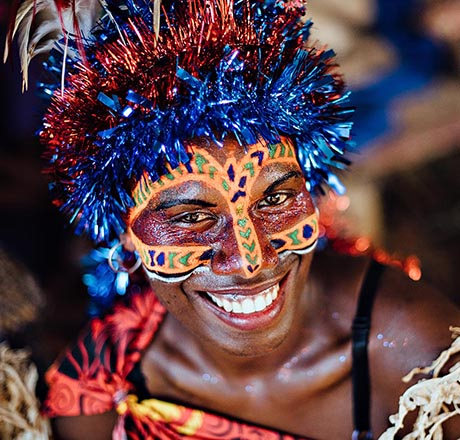Vanuatu
In the footsteps of bushmen
But it’s not what you might think—the man is a traditional bushman, wearing cultural namba (a leaf penis sheath), and he’s guiding us through Malekula’s drenched jungle.


Actually, he’s more than guiding us. He’s saving us. After falling three hours behind schedule, our trekking day has turned into a long, torrential trekking night. So any shortcut, even if it means striding waist-deep through a river during a storm, is welcome. But as we continue to trudge, dripping and mud-caked, into a sugarcane field—the stalks so tall they block out the moonlight—I start to question why I came to Vanuatu. And why, specifically, I agreed to hike the Manbush Trail.
Then, with a crash of thunder to match my epiphany, I remember—because I like my adventure served with a side of challenge. And it’s been too long between expeditions.


Shaped like a sitting dog, Malekula is the second largest and one of the most culturally diverse islands in Vanuatu’s archipelago. And yet it’s also one of the least-visited thanks to its reputation for being remote and inaccessible (oh, and historically cannibalistic). Flying into Malekula, the island certainly looks remote and inaccessible. From above, its jungle is an impenetrable fortress of green, dotted with rivers that glint like lost gold and a smattering of thatched roofs. No major highways or signs of beach-side mai tais. Just the way I like my islands.




“Slowly, slowly,” says Eddie, one of the local guides, as we brave a particularly strong current. Eddie is half my height, and probably half my weight too, but he’s got a vice-like grip on my upper arm—the only thing stopping me from sailing downstream. As we make it to the other side, pants wet but cameras dry, he high-fives me. I think Eddie is enjoying himself. I’m enjoying myself too.
Watch the full adventure
I’m trekking with a small group of Ni-Vans (Vanuatu people) from neighbouring islands; an Australian travel photographer; and a crew of local guides and porters. For the first few days, we tackle the Dog’s Head Trek—a coast-to-coast traverse from the east to the west part of the island’s north. The region here is split into Smol Nambas and Big Nambas tribal territory and is packed with ancient stories, myths and legends. And some of Vanuatu’s most remote bush villages.
The days are sweaty as we explore the volcanic landscape; walking through lush rainforest, stopping to eat fluffy navara (coconut heart) and crack open nangainuts. I suck on sweet cacao flesh, drink fresh water out of a bamboo trunk and taste the centre of a palm tree. It’s a bit like creamed corn. “You’ll never go hungry in the jungle,” says Stepson, a Malekula local who now calls Port Vila home. And I believe him; this trek has turned into quite the food tour.


Speaking of food, we’re quickly—and intimately—acquainted with Vanuatu’s national dish, lap lap. Like a gelatinous cake crossed with a casserole that’s made love to a stew, lap lap is made from grated root vegetables (often taro or yam) wrapped in banana leaves and baked underground. Then slathered in fresh coconut. It’s a hearty meal and good trekking fuel, even if the texture takes a little getting used to.
The interior of Malekula is basically ‘on-foot only’, meaning vehicle access is patchy in parts and completely off the table in others. How these communities got solar panels, rainwater tanks and roof sheeting to the far flung corners of this jungle is borderline miraculous. But here they all are—their little bare-chested kids running out as sentinels as we arrive.
Click play to watch
I shake hands with chiefs and smile at local mamas; I coo at tiny babies and take photos with kids. I feel like the president doing an electoral meet-and-greet. It’s customary to welcome guests with food, so we’re ushered into homes to feast on freshwater prawns and juicy hunks of paw paw. I’ve been told in the past that Ni-Vans are the friendliest people in the world, and this level of hospitality is only proving it to be true. At night we bucket shower off the sweat and sleep on the floor of local huts, waking with the crow of early rising roosters.
The Manbush Trail, on the other hand, is more extreme. The days are longer, the landscape is larger and the villages are even more isolated. It’s a five-night odyssey; exactly the kind of journey I’ve been craving.


We’re joined on the first day by Robert, chief of 13 clans and big man in town. Robert is the brains behind the Manbush Trail, having liaised with all the villages along the 70-kilometre route to bring it to life. In the morning, he teaches me how to husk a coconut. At lunch, he shows us how to light a fire “like a real bushman”. As we climb and scramble, slip and slide, up and down the dense valleys, his rallying cries (somewhere between a yodel and cooee) ring louder than the cicadas. Men from nearby villages cry back at him.
At night, Robert welcomes us to the land with a kava ceremony at the nakamal (meeting hut). Kava is an earthy-tasting traditional drink—dating back over 3,000 years—made from the root of the kava plant and served in half a coconut shell. Known for its calming effects on the nervous system, Ni-Vans like to say ‘alcohol makes you stupid but kava makes you wise’.
“Drinking kava is bonding,” Stepson explains to me, handing over a shell. “We drink it in the dark, in the quiet—it’ll make you feel so peaceful.” Turns out Stepson’s a bit of a kava king, so I’m learning how to imbibe from the right guy. That night he downs three shells; his snores echo through the hut walls.
I stop trying to stay dry and learn to embrace the daily downpours. One day, in between showers, we eat lunch—roasted taro and wild boar—on a cloud of banana leaves. We use a banana leaf as a plate. Sometimes as an umbrella. The night before we even slept on banana leaves. Ben, the travel photographer, tells me his fitness watch tracked it as his best recorded REM in months. Five-star beds? Don’t need them.
On the third day, George—another local guide—signals for us to stop by a huge, Tarzan-like banyan tree. “We’re about to enter a kastomarea,” he says. “From here, until I say, we have to be quiet. No spitting. No talking. No toilet stops.” This taboo area is a sacred place, it's blessed with salt water, despite being nowhere near the sea.
Our group falls into single trekking file as we navigate the roots and rocks down hill. The rain eases, as if even its droplets are too loud. A bird, somewhere to my left, takes flight and I hear the soft rustle of its wings. I’ve never experienced a jungle falling silent before; goosebumps break out over my body that have nothing to do with the breeze. Trekking the Manbush is some of the most technical hiking I’ve ever done, but doing it in silence is an almost meditative experience.
I'm learning that there's a lot of magic here. Like the spring that promises eternal youth (the porters knocked back litres of the stuff) or the part of the forest where whistling is outlawed (because it will bring on a plague of mosquitoes) and the couple who had an affair and were subsequently turned into banyan trees.


And then there’s the sea, which appears like a magical mirage on the horizon, just as my bones start to feel weary and my boots begin to rub. In a collective daze—trekkers and guides and porters alike—we do the final slog down to the coast and collapse into the water. Clothes, and in some cases, boots, still on.
We let the Pacific Ocean soothe our cuts and scrapes. We wash the sweat from our hair. And in true Malekula style, it starts to rain. Heavy, pounding drops that cloud the water and sting my face. And I can’t help but laugh—I came to Malekula craving an adventure, and that’s exactly what Malekula delivered. A soggy, scenic, spectacular adventure.
Now I just need a kava shell, or two, to celebrate.
 (
(














